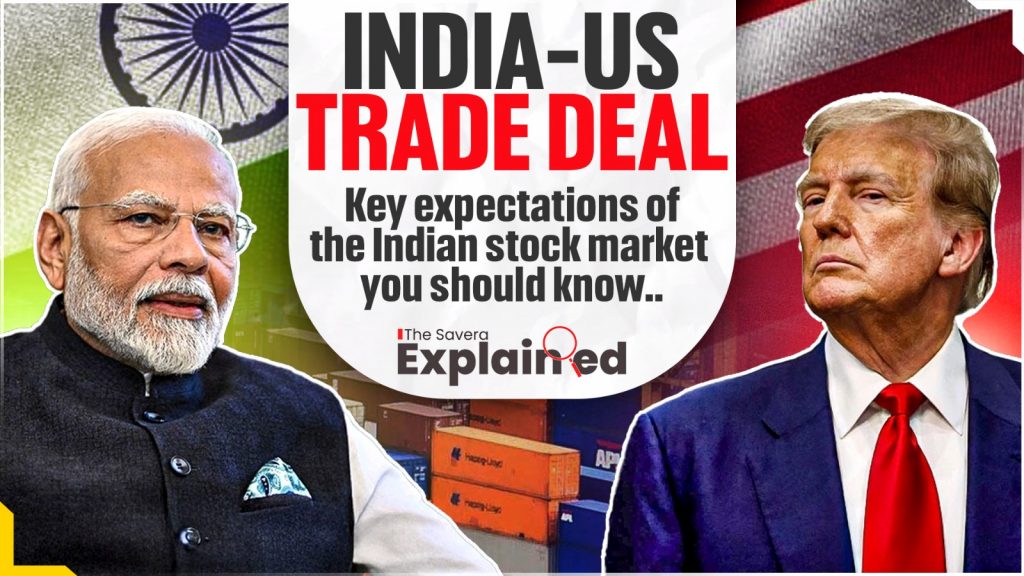India and the United States are currently in the final stages of negotiating a trade agreement. This deal aims to reduce tariffs (taxes on imports/exports), improve market access, and resolve long-standing trade issues between the two countries.
A deadline of July 9, 2025 has been set for announcing at least a partial agreement. However, experts believe that a full, long-term deal may take up to 2–3 years and come in multiple phases.
Why is this Deal Important?
The India-U.S. Bilateral Trade Agreement (BTA) aims to boost trade to $500 billion by 2030. Launched on February 13, 2025, under the “U.S.-India COMPACT” initiative, it followed a Modi-Trump meeting to enhance economic ties. Negotiations, intensified by a U.S. 26% tariff threat (paused until July 9, 2025), focus on tariff reductions, with India seeking exemptions for textiles and leather, and the U.S. pushing for agricultural access.
The deal is important, as it could have several impacts:
- It could boost the Indian stock market:
A favourable trade deal could increase investor confidence and push frontline indices like the Sensex and Nifty to record highs. - It reduces uncertainty:
Ongoing trade tensions have made foreign investors cautious. A deal would clear the air and attract more Foreign Institutional Investment (FII). - It strengthens India’s global position:
A successful deal with the world’s largest economy signals diplomatic and economic strength for India.
What’s Holding Up the Deal?
Despite being close to a deal, both sides are stuck on key issues:
- US wants more access to Indian dairy and agricultural markets.
- India is cautious about exposing its local farmers and protecting data and digital trade rules.
- Tariff disagreements remain on industrial goods, digital services, and medical devices.
What Happens if There’s No Deal by July 9?
If the deadline is missed, Indian exports to the US will face a 36% total tariff:
- 10% baseline tariff +
- 26% reciprocal tariff (announced by Trump in April).
This would make Indian goods less competitive in the US market, hurting sectors like textiles, pharma, and auto parts.
What is Likely to Happen?
Experts believe that both countries may announce “quick wins” soon, such as:
- Lower tariffs in non-sensitive areas
- More purchases of US oil, gas, and defence equipment
- Relaxed trade in luxury vehicles (e.g., Harley-Davidson)
Meanwhile, sensitive issues like agriculture, dairy, and digital trade may be deferred for future negotiations.
What Does the Indian Stock Market Expect?
The Indian stock market anticipates a boost from the India-U.S. Bilateral Trade Agreement (BTA), with expectations of tariff reductions enhancing export-driven sectors like autos, textiles, pharmaceuticals, and renewables. Companies such as Tata Motors, Sun Pharma, and Titan could see gains due to improved U.S. market access.
Indian markets are hoping the deal will include:
- Removal or reduction of tariffs on:
- IT services
- Pharmaceuticals
- Textiles
- Electronics
- Auto components
- Avoidance of the 26% US tariff threat
- Boost in exports and sector-wise growth
- Strengthened investor sentiment
Expert Opinions
- According to Lead Economist Madhavi Arora from Emkay Global:
The deal is likely to be rolled out in phases over 2–3 years. Expect early gains in non-sensitive sectors, while difficult issues will take more time. - According to Ajit Mishra SVP of research at from Religare Broking:
Lower tariffs on pharma, electronics, auto parts, and steel will benefit export-heavy sectors. Overall trade clarity could also encourage FIIs to return to Indian markets. - According to Sujan Hajra, chief economist and executive director from Anand Rathi Group:
A successful deal would resolve key disputes in agriculture, dairy, digital rules, and tariffs — boosting trade and investor confidence. - According to VK Vijayakumar from Geojit Investments:
India will likely not compromise on agriculture or dairy. But it may allow more imports of luxury cars, LNG, and defence items to help the US reduce its trade deficit.
Why India Has an Advantage
- Domestic consumption-driven economy: India is less vulnerable to trade wars.
- Low trade surplus with the US: India doesn’t export enough to be heavily hit.
- Only 1.1% of India’s GDP comes from the sectors at highest risk (textiles, pharma, etc.).
This gives India more flexibility in negotiations.
What’s at Stake?
A successful India-US trade deal could:
- Boost Indian exports and GDP
- Attract more foreign investment
- Improve bilateral ties
- Support Make-in-India and self-reliant manufacturing goals
But missing the deadline or ending with only partial wins might hurt short-term market performance.
The India-US trade deal is more than just about tariffs — it’s a signal of India’s global economic ambition. While it’s unlikely that all issues will be resolved by July 9, even a partial agreement could give a strong push to Indian markets. Over the next few years, expect deeper negotiations as both sides look to reshape one of the world’s most important trade relationships.
